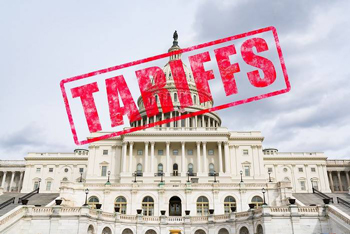By SEMA Washington, D.C., Staff
 The tariffs being imposed are impacting most SEMA members directly or indirectly through their supply chains whereby raw materials and components are transformed into a final product. |
Every business depends on predictable supply costs. When it comes to this basic entrepreneurial principle, 2018 was not a good year. The Trump Administration imposed a series of tariffs with little warning. These measures were intended to address unfair trade practices and encourage foreign nations to renegotiate trade pacts to remove or equalize duty rates. Unfortunately, it hasn’t exactly worked out that way. Make no mistake, SEMA supports the goal of fair trade but questions the methods being employed to bring other countries to the bargaining table. The results to date have been modest when compared to the upheaval being caused in the marketplace.
It’s unclear how or when trade tensions will be resolved. That’s a problem—businesses need certainty. As this article is being written, it is unknown whether U.S./Chinese negotiations will result in tariffs being removed or increased on March 1, or whether President Trump will impose tariffs on imported automobiles and auto parts. What can be said with certainty is this: few if any companies budgeted for tariffs in 2018.
Tariffs have traditionally been considered a last resort in trade battles. There are many other mechanisms that can be employed first, such as filing product dumping and foreign subsidy actions or pursuing emergency import safeguard protections. Sanctions can be imposed to address counterfeiting and other intellectual property disputes. Our international trading partners can also collaborate to work collectively to contest unfair trade practices.
The tariffs being imposed are impacting most SEMA members directly or indirectly through their supply chains whereby raw materials and components are transformed into a final product. Some members may welcome certain tariffs, such as those imposed on Chinese products that compete with products made in the United States. However, if they used domestic steel or aluminum to produce their goods, prices for those commodities skyrocketed when the metal tariffs were imposed.
Tariffs are a sledgehammer approach with unintended consequences. Once imposed, they become difficult to withdraw as other countries pursue retaliatory measures. In fact, tariffs may ultimately make U.S. manufacturers less competitive in a global economy, which has been reflected by the growing trade imbalance in 2018 even as tariffs have been both implemented and increased.
One of the desired results of the Trump Administration tariffs is to coax companies to produce their products in the United States in order to create high-paying jobs domestically. When looking at how to increase American manufacturing, it’s important to understand that a decline in the number of U.S. jobs in this sector over the past few decades is largely the result of increased productivity, automation and U.S. companies availing themselves of efficiencies created by the global supply chain. After World War II, countries were encouraged to abandon protectionist trade policies and work within a rules-based, open trading system. Although globalization has created problems that need to be addressed, it has generally produced widespread benefits ranging from more prosperity, lower prices, greater consumer choice and easing of international tensions.
Companies are now scrambling to address the impact of unexpected and significant tariffs on their supply chains. Some businesses are revisiting whether it is possible to source supplies domestically or from countries not subject to tariffs. Uncertainty clouds those decisions since domestic sources may be unavailable or not price-competitive. Further, a company may relocate its supply chain from one country to another to avoid tariffs, only to find that the Trump Administration has imposed auto-parts tariffs on that country as well.
Other tariff side effects include stockpiling and hoarding. Companies have been stockpiling inventory to avoid threatened higher tariffs. That has resulted in warehouse storage costs, a higher national trade deficit and, with respect to steel and aluminum, artificial price spikes.
Companies ultimately face the decision of how to pay for the tariffs, which are essentially a tax collected by the U.S. government. Choices include absorbing the costs, raising product prices, renegotiating supplier contracts, resourcing supplies, reducing spending in other areas to offset costs and laying off workers.
SEMA has joined forces with many other industry organizations in urging the Trump Administration and U.S. Congress to abandon unilateral tariffs as a tool for resolving trade disputes. We will keep you informed on progress to address these issues.
| Current Tariffs & Tariff Threats | |
There are currently two trade actions spurring tariffs on imported goods, and a third in the works. Metal Tariffs: Last spring, tariffs were imposed on imports of steel (25%) and aluminum (10%) from every nation except a few countries that negotiated quotas (Argentina, Australia, Brazil, South Korea). Chinese Tariffs: Last summer, President Trump targeted Chinese imports, imposing 25% tariffs on $50 billion worth of Chinese products, including some metal, rubber and plastic parts for auto equipment. In September, 10% tariffs were imposed on another $200 billion worth of Chinese products, including many auto parts from engines to tires, gaskets and suspension components. The tariffs will increase to 25% on March 1 if the trade dispute between the two nations has not been resolved. President Trump has also threatened to impose 25% tariffs on the remaining $267 billion worth of Chinese imports. Auto/Auto Parts Tariffs: Last summer, the President directed the U.S. Department of Commerce to investigate whether to impose tariffs on imported automobiles and auto parts if it is found that they pose a threat to America’s national security. A finding is due by mid-February. Global tariffs of 20%–25% could be imposed on all types of cars and parts, including new cars, classic cars, OEM parts and specialty auto parts. |





